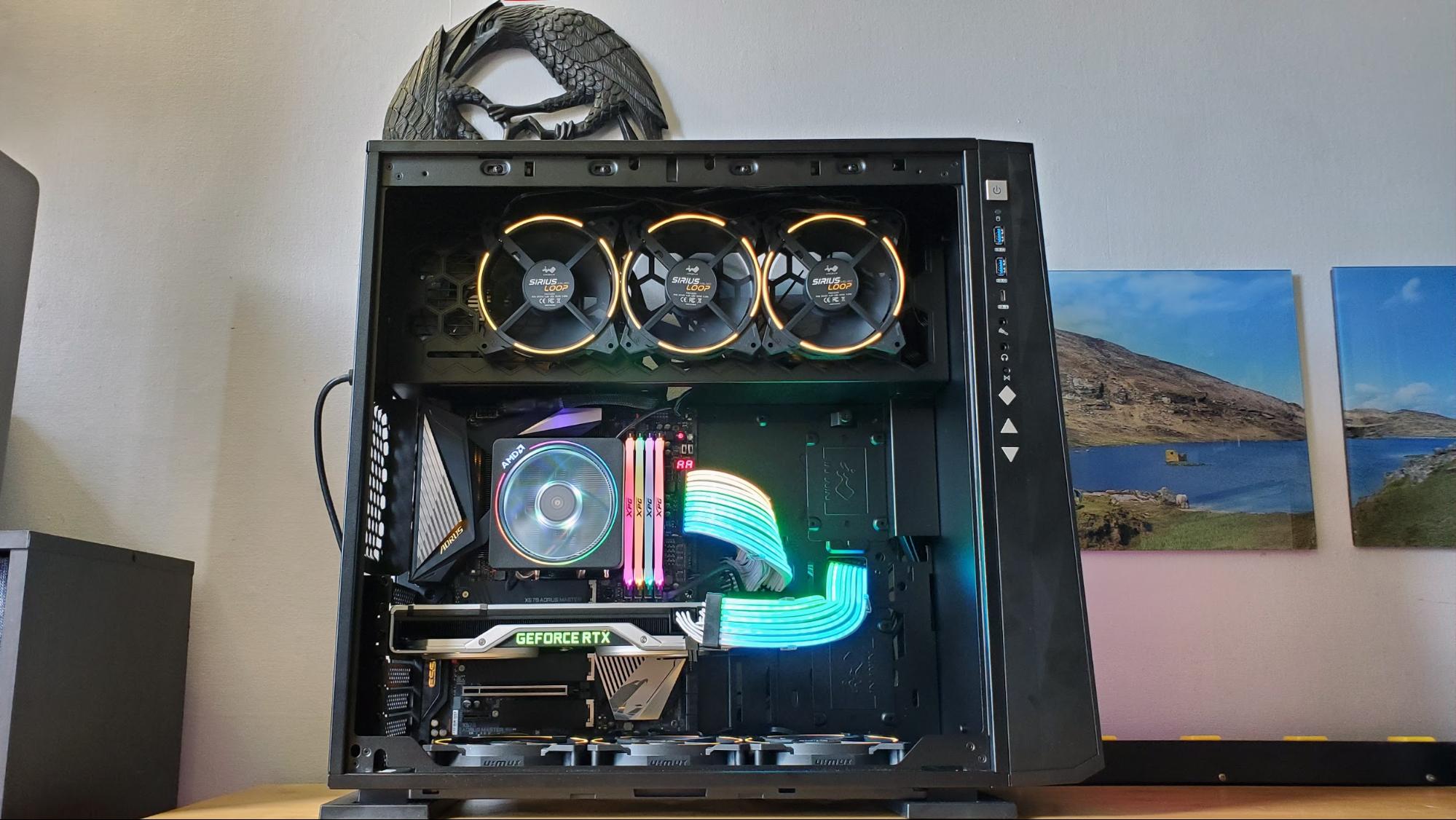The Disco Pixel PC: Building a Flashy, Formidable Mid-Tower in InWin’s 309 Case
It’s like a Lite-Brite that you can overclock
From the moment I first saw InWin’s 309 mid-tower case back at Comptex 2019, I was intrigued by its unique 144-pixel front panel and slick-looking GLOW2 software that lets you design your own light show right on your PC. So when the company offered up the case right as much of the world started heading toward a pandemic-induced lockdown, I grabbed parts for a build that would be both colorful (including Lian Li’s Strimer Plus and some RGB RAM from Adata ) as well as capable. The core components include one of the best gaming CPUs, AMD’s Ryzen 7 3700X and Nvidia’s RTX 2070 Super Founders Edition, our current pick for the best graphics card for 1440p gaming.
Holed up inside my home office, I got to assembling a system that was certain to brighten my days spent in relative isolation. I wasn’t sure what I’d call it when I started showing it off to colleagues over video chats, everyone (of a certain age) said it reminded them of the disco days and lo, the Disco Pixel Build was born.
Having recently worked on the jam-packed RGBaby build, it was a relief to be building in a roomy mid-tower case again, where there was actually a reasonable amount of room for components, cables and the fingers required to fiddle with them. But that doesn’t mean everything about this build was simple.
Storage wasn’t a problem, as I just went with what I had and slipped a 2TB Intel 660p (it’s a good budget drive, but not currently one of the best SSDs) in the first M.2 slot under the heat spreader of Gigabyte’s X570 Aorus Master motherboard. But InWin also sent along six of its Sirius Loop ASL120 fans. And the spinners do have built-in fan and ARGB splitters so you can helpfully daisy chain them together. That meant I could plug them into headers on the board rather than having to wire everything to some kind of RGB/fan hub. But I can now tell you from personal experience that three-pin RGB connectors get very finicky when you try and string six of them together and onto a motherboard connector. I eventually had to resort to electrical tape to hold them together, and even then it seemed like one or more would occasionally disconnect when I so much as looked at the system sideways.
Before I get too much more into the joys and frustrations of the Disco Pixel PC, let’s take a closer look at the parts I used.
Components for Disco Pixel PC Build
Case: InWin 309
The brighter, edgier (and I’d argue sleeker) followup to the 307 that launched in 2018, InWin’s 309 is a tempered-glass midtower case with an eye-catching front panel that packs in 144 bright, addressable pixels. You can control the light show via buttons on the front-left edge, and switch between a number of built-in patterns (including some awesome retro-arcade designs), or you can design your own patterns via the company’s surprisingly slick and capable GLOW2 software.
While the light show up front is second to none, the 309 can be challenging -- or at least counter-intuitive -- from an airflow perspective. The front panel is completely closed off from air, due to the addressable pixel array, and the top is a solid sheet of steel. Given that, it’s unlikely that the 309 would wind up on our list of best PC cases. There are some cutouts on the steel right side panel of the case, but the vast majority of the system’s airflow is going to have to come in from the mesh bottom and be exhausted out of the back.
This is further complicated by the fact that the current iteration of the InWin 309 ships without any fans at all. But the company did send us six of its neon-like RGB Sirius Loop fans to get the air moving. We could have actually used a seventh.
CPU: AMD Ryzen 7 3700X
What’s left to be said about AMD’s Ryzen 7 3700X? It’s been around for going on a year, but its 8 cores, 16 threads, and current sub-$300 price means it’s still sitting pretty on our best gaming CPUs page as the best overall value, offering double the threads of Intel’s pricier Core i7-9700K, while still delivering very good gaming and productivity performance. Plus, it includes an attractive bundled cooler.
Get Tom's Hardware's best news and in-depth reviews, straight to your inbox.
CPU Cooler: AMD Wraith Prism
If the world weren’t upside down right now, we probably would have gone with an AIO for this build. But many etailers are experiencing shipping delays, our lab is currently locked down in Midtown Manhattan, and I didn’t want to deal with the hassle of trying to get one of our off-site writers to ship me something else. The fact of the matter is, AMD’s Wraith Prism is more than good enough, delivering solid cooling, a little room for overclocking, and an RGB light ring and fan--all in a compact, easy-to-install package that comes free in the box with AMD’s Ryzen processor. It’s hard to argue with free, especially when it’s this capable, pretty, and Intel doesn’t ship a cooler with its unlocked processors at all.
Graphics Card: Nvidia GeForce GTX 2070 Super Founders Edition
This is another area where, given different circumstances, we probably would have gone with a flashier GPU with RGBs and some out-of-the-box overclocking. But the 2070 Super Founders Edition was close to hand, a capable performer, and I’d argue that--while it doesn’t light up beyond the GeForce RTX logo--its silver metal shell makes it prettier than the vast majority of third-party cards. That’s 1,000 points for aesthetics, Nvidia. But even at idle, I can hear the card’s fans spinning from across the room as I write this. Maybe it’s time to implement a zero-RPM fan mode like many of your third-party partners?
Motherboard: Gigabyte X570 Aorus Master
For what I installed in it, the ATX Gigabyte X570 Aorus Master is arguably overkill, with its three M.2 slots, 2.5GB Ethernet and Wi-Fi 6. But who doesn’t love next-gen connectivity and expansion options aplenty.The board also looks good, and its RGB and fan headers are laid out in such a way that most were exactly where I wanted them for this build. How often does that happen?
Power Supply: Corsair RM 750x
The power supply gets mounted up top, behind a honeycomb-cut chamber in this case, so it’s not all that visible. I went with Corsair’s RM 750x because it’s fully modular and has enough wattage headroom for substantial future upgrades. Its fan also sits at idle during low loads, which is something I wish Nvidia could figure out with its FE graphics cards.
RAM: 32GB DDR4-3600 Adata XPG Spectrix D41
3600 MHz is the sweet spot for Ryzen 3000 support, so I went with Adata’s Spectrix D41 3600 kit, which brings aggressive red metal heat spreaders and some diffused RGB glow up top. While the red of the spreaders doesn’t really match the rest of the interior, with four sticks jammed in close together, all you can really see of the memory is the RGB lighting on the top edge, anyway.
Storage: 2TB Intel 660p
In different times, we’d have probably gone with a PCIe 4.0 SSD with this build, to take advantage of one of X570’s key features. But as I started thinking about assembling this build, I remembered I had a spare 2TB Intel 660p in an external enclosure that I’d bought last year when a third-party seller was very briefly offering it up for less than $103. I didn’t exactly need it at the time, but how do you pass up a nickel-per-gig for PCIe solid-state storage?
For the last six months or so, the drive has been living inside an M.2 enclosure as a seriously roomy and fairly speedy external SSD. Now it lives behind a metal heatsink as the sole storage device inside the Disco Pixel PC. Sure, it doesn’t have any lights, but it’s not like you’d be able to easily see a lit-up M.2 drive with everything else we’re putting in this build, anyway.
Fans: 6x Sirius Loop ASL120
The version of the Inwin 309 case that the company is currently selling ships with no fans--something that’s becoming increasingly common in cases where companies know you’re going to be designing a showy build, and so will likely want to use specific spinners from another company.
For our purposes, InWin sent along a pair of three-packs of its Sirius Loop ASL120 fans. They aren’t the most vivid of RGB air movers, but the thin neon-like light strip that runs around the outside looks downright understated compared to the front panel and our next component. For the sake of symmetry, we installed three on the bottom as intakes, and three up top where a radiator might go if you were installing one in the case. As noted earlier, we would have liked a seventh fan to use for exhaust, and for long-term use with this system, we’d move one of the fans from up top if need be. But we left the three fans up top here because it looked the best that way and we weren’t easily able to get another matching fan for exhaust.
RGB Cable Extensions: Lian Li Strimer Plus
Perhaps the only RGB product that could visually compete with the 144-pixel front panel of the Inwin 309 case is Lian Li’s updated Strimer Plus RGB extension cables. I had these on hand from our recent review, and they were an obvious pairing for such a vivid build. Plus, unlike with the too-cramped RGBaby build, there was actually room here behind the motherboard for the extra ATX and PCIe power cables that result from using the sleeved Strimer Plus extensions.
| Header Cell - Column 0 | Product | Cost |
|---|---|---|
| PC Case | InWin 309 | $199.00 |
| CPU | AMD Ryzen 7 3700X | $294.14 |
| CPU Cooler | AMD Wraith Prism | (included with CPU) |
| Graphics Card | Nvidia GeForce GTX 2070 Super Founders Edition | $499.99 |
| Motherboard | Gigabyte X570 Aorus Master | $359.00 |
| Power Supply | Corsair RM 750x | $149.99 |
| RAM | 32GB DDR4-3600 Adata XPG Spectrix D41 | $127.99 (x2) |
| Storage | 2TB Intel 660p | $219.99 |
| Fans | 6x Sirius Loop ASL120 | $25.08 (x2) |
| RGB Cable Extensions | Lian Li Strimer Plus (24-pin, PCIe | $89.98 |
| TOTAL | Row 10 - Cell 1 | $2,118.23 |
Current page: The Parts to Build the Disco Pixel PC
Next Page Build Notes: Room to Breathe and Daisy Chain PainAfter a rough start with the Mattel Aquarius as a child, Matt built his first PC in the late 1990s and ventured into mild PC modding in the early 2000s. He’s spent the last 15 years covering emerging technology for Smithsonian, Popular Science, and Consumer Reports, while testing components and PCs for Computer Shopper, PCMag and Digital Trends.
-
Unolocogringo You weren't one of those hippie type fellas were you?Reply
If so welcome to the club!!!
I sort of remember those days,most of them anyway.
As for the build????
I think garish would be putting it nicely.
But to each his/her own! -
deesider I don't get what the top fans are doing - isn't the exit from the top chamber blocked by the PSU?Reply -
Unolocogringo Reply
Th power supply inlet is behind the rear fan. the other two fans blow into an empty chamber that has vents on the right case panel.deesider said:I don't get what the top fans are doing - isn't the exit from the top chamber blocked by the PSU?

